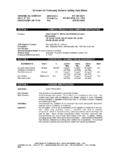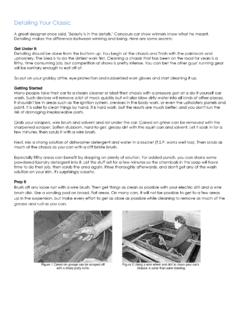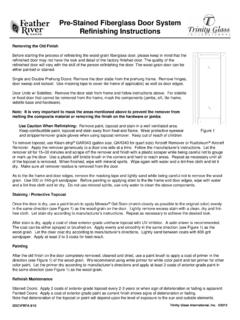Transcription of 7769830 Rust-Oleum Stops Rus Rusty Metal …
1 7769830 Rust-Oleum Stops Rus Rusty Metal Primer Aerosol Page 1 of 6. Material Safety Data 24 Hour Assistance: 1-847-367-7700. Sheet Rust-Oleum Corp. Section 1 - Chemical Product / Company Information rust - oleum Stops Rus Rusty Metal Product Name: Revision Date: 01/18/2008. Primer Aerosol Identification 7769830 . Number: Product Use/Class: Primer/Aerosol Supplier: rust - oleum Corporation Manufacturer: Rust-Oleum Corporation 11 Hawthorn Parkway 11 Hawthorn Parkway Vernon Hills, IL 60061 Vernon Hills, IL 60061. USA USA. Preparer: Regulatory Department Section 2 - Composition / Information On Ingredients Chemical Name CAS Number Weight % Less Than ACGIH TLV-TWA ACGIH TLV-STEL OSHA PEL-TWA OSHA PEL -CEILING. Liquefied Petroleum Gas 68476-86-8 1000 PPM 1000 PPM Xylene 1330 -20-7 100 PPM 150 PPM 100 PPM Aliphatic Hydrocarbon 64742-89-8 300 PPM 300 PPM Magnesium Silicate 14807-96-6 10 mg/m3 15 mg/m3 Ethylbenzene 100-41 -4 100 PPM 125 PPM 100 PPM Acetone 67-64-1 500 PPM 750 PPM 750 PPM Zinc Phosphate 7779 -90-0 Basic Zinc Molybdate 61583-60-6 10 mg/m3 10 mg/m3 Microcrystalline Silica 14808-60-7 mg/m3 mg/m3 Section 3 - Hazards Identification ** Emergency Overview **: Harmful if inhaled.
2 May affect the brain or nervous system causing dizziness, headache or nausea. Vapors may cause flash fire or explosion. Contents Under Pressure. Extremely flammable liquid and vapor. Harmful if swallowed. Effects Of Overexposure - Eye Contact: Causes eye irritation. Effects Of Overexposure - Skin Contact: Prolonged or repeated contact may cause skin irritation. Substance may cause slight skin irritation. Effects Of Overexposure - Inhalation: High vapor concentrations are irritating to the eyes, nose, throat and lungs. Harmful if inhaled. High gas, vapor, mist or dust concentrations may be harmful if inhaled. Avoid breathing vapors or mists. Effects Of Overexposure - Ingestion: Aspiration hazard if swallowed; can enter lungs and cause damage.
3 Substance may be harmful if swallowed. Effects Of Overexposure - Chronic Hazards: IARC lists Ethylbenzene as a possible human carcinogen (group 2B). May cause central nervous system disorder (e,g.,narcosis involving a loss of coordination, weakness, fatigue, 1/18/2008. 7769830 Rust-Oleum Stops Rus Rusty Metal Primer Aerosol Page 2 of 6. mental confusion, and blurred vision) and/or damage. Reports have associated repeated and prolonged occupational overexposure to solvents with permanent brain and nervous system damage. Overexposure to xylene in laboratory animals has been associated with liver abnormalities, kidney, lung, spleen, eye and blood damage as well as reproductive disorders. Effects in humans, due to chronic overexposure, have included liver, cardiac abnormalities and nervous system damage.
4 Contains crystalline silica as silicon dioxide. Excessive inhalation of respirable crystalline silica dust may cause lung disease, silicosis or lung cancer. Significant exposure is not anticipated during brush or trowel application or drying. Risk of overexposure depends on the duration and level of exposure to dust from repeated sanding of surfaces, mechanical abrasion or spray mist and actual concentration of crystalline silica in the formula. Crystalline silica is listed as Group 1 "carcinogenic to humans" by the International Agency for Research on Cancer (IARC,) and Group 2, "reasonably anticipated to be a carcinogen" by the National Toxicology Program (NTP). Primary Route(s) Of Entry: Skin Contact, Skin Absorption, Inhalation, Eye Contact Section 4 - First Aid Measures First Aid - Eye Contact: Hold eyelids apart and flush with plenty of water for at least 15 minutes.
5 Get medical attention. First Aid - Skin Contact: Wash with soap and water. Get medical attention if irritation develops or persists. First Aid - Inhalation: If you experience difficulty in breathing, leave the area to obtain fresh air. If continued difficulty is experienced, get medical assistance immediately. First Aid - Ingestion: Aspiration hazard: Do not induce vomiting or give anything by mouth because this material can enter the lungs and cause severe lung damage. Get immediate medical attention. Section 5 - Fire Fighting Measures Flash Point: -156 F LOWER EXPLOSIVE LIMIT: %. (Setaflash) UPPER EXPLOSIVE LIMIT : %. Extinguishing Media: Dry Chemical, Foam, Water Fog Unusual Fire And Explosion Hazards: FLASH POINT IS LESS THAN 20.
6 F. - EXTREMELY FLAMMABLE LIQUID. AND VAPOR! Perforation of the pressurized container may cause bursting of the can. Isolate from heat, electrical equipment, sparks and open flame. Water spray may be ineffective. Closed containers may explode when exposed to extreme heat. Vapors may form explosive mixtures with air. Vapors can travel to a source of ignition and flash back. Keep containers tightly closed. Special Firefighting Procedures: Evacuate area and fight fire from a safe distance. Section 6 - Accidental Release Measures Steps To Be Taken If Material Is Released Or Spilled: Dispose of according to local, state (provincial) and federal regulations. Do not incinerate closed containers. Remove all sources of ignition, ventilate area and remove with inert absorbent and non-sparking tools.
7 Contain spilled liquid with sand or earth. DO NOT use combustible materials such as sawdust. Section 7 - Handling And Storage Handling: Follow all MSDS/label precautions even after container is emptied because it may retain product 1/18/2008. 7769830 Rust-Oleum Stops Rus Rusty Metal Primer Aerosol Page 3 of 6. residues. Use only in a well-ventilated area. Wash hands before eating. Wash thoroughly after handling. Avoid breathing vapor or mist. Storage: Do not store above 120 F. Store large quantities in buildings designed and protected for storage of NFPA Class I flammable liquids. Contents under pressure. Do not expose to heat or store above 120 F. Keep containers tightly closed. Isolate from heat, electrical equipment, sparks and open flame.
8 Section 8 - Exposure Controls / Personal Protection Engineering Controls: Prevent build-up of vapors by opening all doors and windows to achieve cross -ventilation. Use explosion-proof ventilation equipment. Use process enclosures, local exhaust ventilation, or other engineering controls to control airborne levels below recommended exposure limits. Respiratory Protection: A NIOSH/MSHA approved air purifying respirator with an organic vapor cartridge or canister may be permissible under certain circumstances where airborne concentrations are expected to exceed exposure limits. Protection provided by air purifying respirators is limited. Use a positive pressure air supplied respirator if there is any potential for an uncontrolled release, exposure levels are not known, or any other circumstances where air purifying respirators may not provide adequate protection.
9 A respiratory protection program that meets OSHA. and ANSI requirements must be followed whenever workplace conditions warrant a respirator's use. Skin Protection: Nitrile or Neoprene gloves may afford adequate skin protection. Use impervious gloves to prevent skin contact and absorption of this material through the skin. Eye Protection: Use safety eyewear designed to protect against splash of liquids. Other protective equipment: Refer to safety supervisor or industrial hygienist for further information regarding personal protective equipment and its application. Hygienic Practices: Wash thoroughly with soap and water before eating, drinking or smoking. Section 9 - Physical And Chemical Properties Boiling Range: -34 - 900 F Vapor Density: Heavier than air Odor: Solvent Like Odor Threshold: ND.
10 Appearance: Liquid Evaporation Rate: Faster than Ether Solubility in H2O: Slight Freeze Point: ND Specific Gravity: Vapor Pressure: ND PH: NE. Physical State: Liquid (See section 16 for abbreviation legend). Section 10 - Stability And Reactivity Conditions To Avoid: Avoid temperatures above 120 F. Avoid all possible sources of ignition. Incompatibility: Incompatible with strong oxidizing agents, strong acids and strong alkalies. Hazardous Decomposition: By open flame, carbon monoxide and carbon dioxide. When heated to decomposition, it 1/18/2008. 7769830 Rust-Oleum Stops Rus Rusty Metal Primer Aerosol Page 4 of 6. emits acrid smoke and irritating fumes. Hazardous Polymerization: Will not occur under normal conditions. Stability: This product is stable under normal storage conditions.











